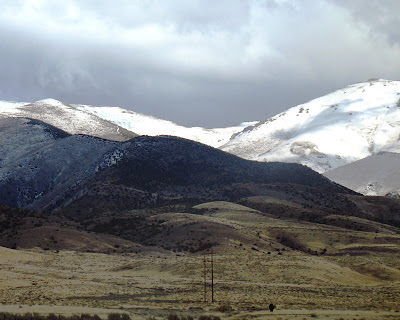There are several ways to line up a drill rig up on an azimuth. (Ya have to know which way to aim the rig unless you're just a random sort of geologist.) One way is to be there, Brunton in hand, sighting on some part of the rig as they line up in the general orientation of your chosen azimuth, which you perhaps mark simply by standing where you want them to point. Then you wave: a little to the right, a little to the left - it's a slow and clumsy way of doing things, IMO. Be sure to stand as far away from the rig as possible so your compass won't get pulled by that vast amount of metal known as the drill rig.
Another way involves biodegradable marking paint - often a fluorescent orange color - which will spray a line on the ground while you hold it upside down.

The first time I was introduced to this kind of spray paint was several years ago while working outside the Florida Canyon Mine area in western Nevada [the ownership of Florida Canyon Mine is sometimes in flux, so some of these links may not remain current].
 Area of drilling interest south of Florida Canyon, as seen looking east from I-80.
Area of drilling interest south of Florida Canyon, as seen looking east from I-80.Instead of just using flagging tied to trees or bushes to mark the way to the next drill site, it can be convenient to spray paint LARGE arrows on the ground for the drillers to follow. It still can be a good idea to either show them the site first or to check up on them during their rig-up phase to make sure they are drilling the right site, but if signals are worked out in advance, that can become unnecessary.
 As far as lining a drill rig up on an azimuth to drill an angle hole, another way is to draw a nice and tidy line on the ground with the above-mentioned spray paint. Because the paint is biodegradable, you can't do this too far in advance of moving the drill rig to the chosen site, especially if the monsoon is in town or if you happen to be expecting a snow storm or ground blizzard. Either one of these circumstances might require a modification of the spray paint method by the addition of using stakes along the laid-out line.
As far as lining a drill rig up on an azimuth to drill an angle hole, another way is to draw a nice and tidy line on the ground with the above-mentioned spray paint. Because the paint is biodegradable, you can't do this too far in advance of moving the drill rig to the chosen site, especially if the monsoon is in town or if you happen to be expecting a snow storm or ground blizzard. Either one of these circumstances might require a modification of the spray paint method by the addition of using stakes along the laid-out line.Stand at the location of the drill collar - where you expect them to drill - or just a little to the right or left of that. Mark the ground (with paint) where you are standing or put a painted stake in the ground. Move down azimuth in the opposite direction. That is, if the azimuth is 180 and you expect them to angle due south, move to the north. They will have to line the rig up in front of the drill collar, and so your line will have to run from the drill collar to the north. After making sure you aren't too close to large metallic objects such as pickup trucks, water trucks, drill pipe, or drill rigs, take a bearing on the stake or spot on the ground until you have lined up at the perfect azimuth. Then mark that spot on the ground or with another stake. Two or three spots farther and farther away from the original one are ideal for making the perfect bearing line, but two can do if you have a tolerance of a degree or so. Then, somehow, make a perfect line between your points using the spray paint.
One way to make a perfect line is to take some rope or string and tie it between the two end points, pull it taught, and paint the rope or string, along with the ground at the same time. Topofil string is ideal for this because it was designed for surveying purposes - it's lightweight, stretches so you can pull it tight even in a wind, and its also biodegradable. Wrap it around the stake at both ends of the line, around the stake and a rock you place on the ground, or around two rocks placed at both ends of the proposed line. Then, carefully paint the string, forming a line similar to the one seen below.
 After that, have the drill rig move on to the site and let them line up with their tires on your painted line, or with their tires at some equal distance from the line. If you want, you can be present while they do this. If they are good at lining up, you might not need to be there.
After that, have the drill rig move on to the site and let them line up with their tires on your painted line, or with their tires at some equal distance from the line. If you want, you can be present while they do this. If they are good at lining up, you might not need to be there.
No comments:
Post a Comment